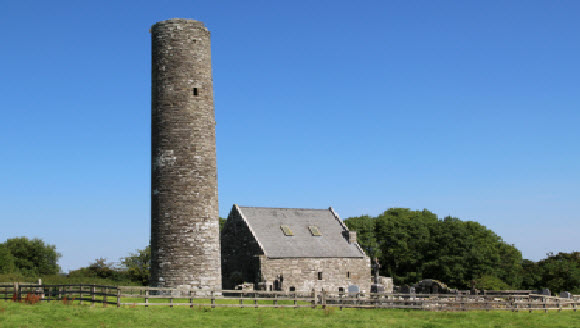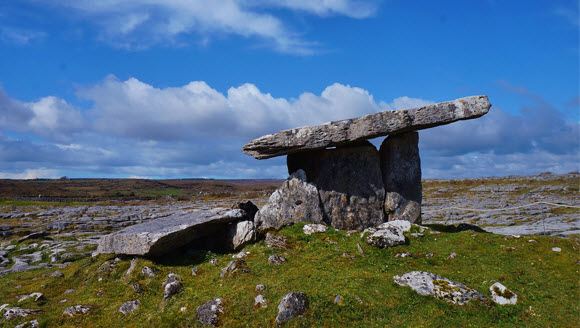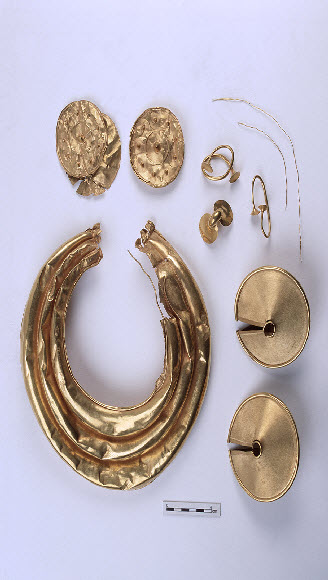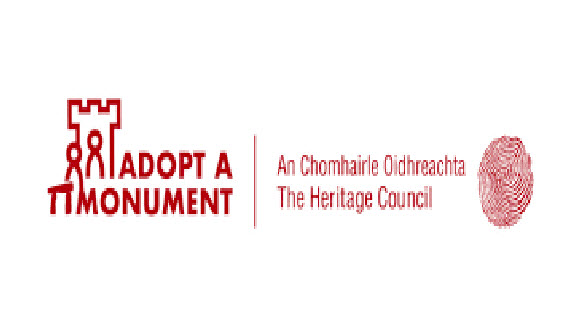Archaeological sites
The Field Monument Adviser Programme operates under the direction of the Burrenbeo Trust and the Heritage Council.

What is archaeology?
Archaeology is the study of past societies through their material remains and the landscapes they lived in. ‘The archaeological heritage consists of such material remains (whether in the form of sites and monuments or artefacts in the sense of moveable objects) and environmental evidence.’ A new vision has recently been produced by the Royal Irish Academy which offers a sustainable, strategic pathway for our archaeological heritage - Archaeology 2025: Strategic Pathways for Archaeology in Ireland [PDF,8.68MB].
County Clare is recognised nationally for its archaeological heritage. For example, some areas of the Burren remain unchanged since the presence of the first farmers and are regarded as prehistoric landscapes fossilised in time. The intensity of monuments is remarkable with 300 recorded ‘Fulacht Fiadh’ (Ancient Cooking Places), 136 cillíní (Children Burial Grounds), 450 ring forts as well as the densest concentration known of wedge tombs in Ireland.
There are 42 monuments in state care in County Clare. The archaeology inventory of County Clare is continually being updated. For further information on recorded monuments see National Monuments Services website. To find out more about archaeology in Clare, visit the Clare Library Website.

The connection between these ancient monuments and ourselves are profound. An RTE television documentary, “Blood of the Irish”, featured an excavation of human remains in Glencurran Cave in the Burren and analysis of ancient DNA.DNA samples were taken from thirteen school children living in the vicinity of the cave and remarkably, three of these showed a strong genetic link with the 3,500-year-old child. For more infomation visit Sligo Institute of Technology website.
Archaeology in Clare
County Clare has one of the highest densities of monuments of any county in Ireland and is particularly rich in early field monuments and ecclesiastical settlements. There are approximately 7,500 known archaeological sites and many more yet undiscovered in the County.
Visit our Architectural Conservation Section to find out more about Clare County Council’s role in the conservation our architectural heritage.
Legislation best practice guidance
The preservation and protection of archaeology is paramount, as is the awareness of the value of archaeology. It is the policy of the council to protect and preserve archaeological sites that have been discovered since the publication of the Record of Monuments and Places.
The publication Archaeology and the Planning Process is a guide to understanding the procedures involved when proposing to carry out development work which might affect our archaeological heritage. It is intended as a practical guide and is not a legal interpretation of the legislation. At present, a monument is protected in one of four ways:
- It is recorded in the Record of Monuments and Places (RMP).
- It is registered in the Register of Historic Monuments (RHM).
- It is a national monument subject to a preservation order (or temporary preservation order).
- It is a national monument in the ownership or guardianship of the Minister for Housing, Local Government and Heritage or a Local Authority.
The Record of Monuments and Places (RMP) is the most widely applying provision of the National Monuments Acts. It comprises a list of recorded monuments and places and accompanying maps on which such monuments and places are shown for each county. It can be consulted in county libraries and main local authority offices. The Records of Monuments and Places for Clare can be accessed on the National Monuments Service website.
Community monument fund
The Community monuments fund was first established in 2020 to provide investment in Ireland’s archaeological heritage. Part of this funding is prioritised for local authorities, private owners and custodians and community groups for the care, conservation, maintenance, protection and promotion of archaeological monuments. To find out more about the Community Monuments Fund in Clare, visit the community monuments page.
Planning legislation
Ireland's planning system was introduced on the 1st October 1964, when the Local Government (Planning and Development) Act, 1963 came into effect.& The law governing the planning system is updated regularly and can be accessed on the Department of Housing, Planning and Local Government Website.
The following legislation, standards and guidelines are central to the conservation of archaeological heritage:
- National Monuments (Amendment) Act 2004
- National Monuments (Amendment) Act 1994
- National Monuments (Amendment) Act 1987
- National Monuments (Amendment) Act 1954
- National Monuments Act 1930
- EIA of Proposed Demolition of National Monuments Regulations 2012
- S.I. 229/2005 - National Monuments Act 1930 (Section 14B) Regulations 2005
- SI 114 of 2013 (EIA re Approved Road Developments)
- Planning and Development Act, 2001
- Heritage Act, 1995
- EPA 'Advice Notes for preparing Environmental Impact Statements' (Draft 2015)
- Frameworks and Principles for the Protection of the Archaeological Heritage, 1999, (formerly) Department of Arts, Heritage, Gaeltacht and Islands.
Ecclesiastical treasures in County Clare
Ecclesiastical treasures in County Clare are presented in a heritage information booklet for visitors to 33 early Christian, medieval and Celtic ecclesiastical buildings in County Clare. It was the first initiative of its kind to be launched in the county and features 33 church heritage sites across four trails throughout County Clare which are supported by text and photographs. The booklet was published as Rian na Manach [PDF,4.72MB].
Historic graveyards/burial grounds
The remarkable tradition of church building in our County goes back a thousand years to the Christian 4th/5th Century in Ireland. Along with providing a resting place for our departed and a place of remembrance, Historic graveyards as opposed to modern Burial Grounds, are of immense heritage value as sites of archaeological and architectural interest, as wildlife habitats and as repositories of local genealogy, sculpture and art. There are approximately 170 historic graveyards in the ownership of Clare County Council and many more throughout the county including Killeen's or children's burial grounds. Clare County Council wish to work with local communities to avail of the Community Monuments Fund 2021 to conserve Medieval Churches in Historic Burial Grounds.
For further information about ecclesiastical heritage in Clare, please see:
- Guidance for the Care, Conservation and Recording of Historic Graveyards [PDF, 7.27MB]
- A Guided Tour of Ecclesiastical Treasures in County Clare [PDF, 4.7MB]
- A Church and Graveyard Survey in County Clare [PDF, 3.9MB]
- Architectural Heritage Protection for Places of Public Worship
- Graveyards – Monuments of County Clare
What to do if you find an artefact?
|
Gorteenreagh Gold Hoard (National Museum of Ireland) |

While the mechanisms in place to preserve our archaeology mean that teams of professionals examine and excavate sites prior to development, many of the great archeologically finds were made by individuals in their own home places. Hugely significant archaeology have been found by individuals in Clare including the Gorteenreagh gold hoard (right), the Glenasheen Collar and The Mooghaun Gold Hoard. For more information on archaeological objects found in Ireland, see Guide to the National Museum of Ireland Archaeology [PDF,2.25MB].
All archaeological objects that come to light belong to the State and should be reported to the National Museum of Ireland or a designated local museum within 96 hours of the discovery. If you find an artefact, please contact the National Museum of Ireland as soon as possible. Alternatively, Clare Museum in Ennis, holds MSPI accreditation and is designated to collect archaeological finds.
The Discovery Programme is an all-island centre for archaeology and heritage science. Its core objectives are the enhancement of the understanding of Ireland’s past, primarily through the interpretation of its archaeological record, and the communication of that understanding to as wide an audience as possible.
Protect our past
The Protect our past campaign is led by the Department of Housing, Local Government and Heritage and urges visitors to heritage sites to be mindful of their actions. The focus of the campaign is to raise awareness of the value, importance, and sensitivity of Ireland’s built heritage and to convey some key messages around visitor behaviour at monuments. The campaign is a joint initiative of the Office of Public Works and the National Monuments Service (DHLGH). A short guide has been produced for visitors available here on Rialtas na hEireann website. You may know of local heritage sites that may benefit from awareness raising on your social media channels. #ProtectOurPast campaign information is available on the Office of Public Works website.
Built heritage surveys in County Clare
The built heritage of the County has a practical role in shaping a positive future of County Clare. Under various Clare Heritage Plans, the Clare Heritage Office delivered the following surveys which illuminate the built heritage of the County.
- Clare Coastal Architectural Survey [PDF,15.2MB]
- Doonbeg Vernacular Survey 2000 [PDF,.12MB]
- Clare Industrial Heritage Survey 2008 [PDF,10.5MB]
- Clare Railway Bridge Survey (Interim) 2015 [PDF, 3.8MB]
- Clare Stone Slate Roof Survey 2007 [PDF,1.5MB]
- Clare Thatched Building Survey 2005 [PDF,.6MB]
- Clare Town & Village Photographic Survey 2009 [PDF, 62.2MB]
- West Clare Railway Structures Survey 2005 [PDF,1MB]

The Adopt a Monument Scheme was developed by the Heritage Council to encourage communities to become actively involved in the conservation of their local archaeological and cultural heritage sites. The Heritage Council offers expertise, mentoring and support so that local communities can preserve monuments that are unique to their own area and this increases the civic value of these sites. In 2019, two monuments were adopted through this community scheme in County Clare. The monuments were:
This Guidance For Community Archaeology Projects [PDF,3.71MB] manual aims to provide a framework and guidance to community groups who wish to actively engage with their heritage
Protect our past
The Protect our past campaign is led by the Department of Housing, Local Government and Heritage and urges visitors to heritage sites to be mindful of their actions. The focus of the campaign is to raise awareness of the value, importance, and sensitivity of Ireland’s built heritage and to convey some key messages around visitor behaviour at monuments. Watch a short video about the campaign available here on YouTube.
The campaign is a joint initiative of the Office of Public Works and the National Monuments Service (DHLGH). The Department and OPW share on respective social media channels a series of animated videos to highlight the impact that inappropriate behaviour can have on sites. You may know of local heritage sites that may benefit from awareness raising on your social media channels. #ProtectOurPast campaign information is available on Office of Public Works website.
Contact
Michael LynchClare Field Monument Adviser, Burrenbeo
Page last reviewed: 10/03/22
Content managed by: Heritage unit (within Planning department)
Back to topContact
Clare Field Monument Adviser, Burrenbeo
Glebe Road
Kinvara
Co. Galway
Heritage Planning Department Clare County Council
Áras Contae an Chláir
New Road
Ennis
Co. Clare
V95 DXP2
(065) 684 6407
This is just for feedback on our web site, not comments or questions about our services.
To tell us about anything else, go to our contact us pages.
